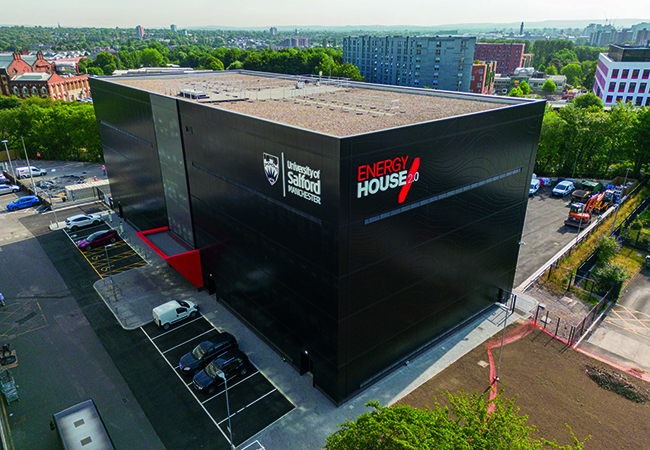
Demand-response strategies can make big inroads into energy use
The Future Homes Standard, demand-response strategies and non-domestic retrofits were among the key areas covered at the annual DESNZ/IEA Heat Pump Research Seminar in London last month.
A significant part of the day was dedicated to talks on demand-side flexibility, and in particular how heat pump usage can be adjusted to reduce stress on the electricity grid and cut energy bills for consumers.
Ryan Huxtable, future capability programme lead at National Grid, shared details of the three-year Equinox trial, which rewarded consumers for temporarily altering their heat pumps to relieve stress on the electricity network.
Consumers were given notice periods to turn down their heating for two hours at peak demand and three notice periods were tested. The trial found a statistically significant demand response from the 1,048 participating households. For example, across all events from 5-7pm there was a 48% reduction in the average home’s peak load, equivalent to a 0.6kW peak reduction per event.
Huxtable said that average demand response for each heat pump was scaled up across several scenarios in an area of constrained electricity capacity. It was found that heat pumps’ demand response could mitigate 20% of the area’s projected peak demand by 2028.
The Latent project, run by the University of Southampton and Good Energy, conducted a field trial to test third-party control of electric heating systems, to assess behaviour, attitudes and dwelling thermal response.
‘Heating can be contentious. We wanted to understand if we could turn off a heat pump without people being aware that it was happening,’ said Professor Patrick James, of the University of Southampton.
Before the project began, a survey of 5,000 Igloo customers found that 55% opposed energy companies remotely controlling their heating. The trial showed that, when heating was turned off, temperatures dropped, but most participants did not notice. Even after five deferrals in one week, 62% of participants believed no events had occurred.
Shifting loads
The Centre for Net Zero’s Daniel Lopez Garcia and Nesta’s Oli Berry discussed findings from the HeatFlex project, a load-shifting trial that tested automated control of heat pumps while maintaining thermal comfort.
The collaboration between Nesta and the Centre for Net Zero aimed to shift household demand away from periods of high Grid demand by turning heat pumps down after a period of pre-heating. The intervention was automated, so no action was needed by occupants, and the trial maintained temperatures specified by households.
It was found that average temperatures changed by less than 1°C and 81% of occupants were satisfied or very satisfied with internal temperatures. There was also a 0.123kWh reduction in energy consumption during the flexibility window. Garcia and Berry said the potential for flexible windows was less for homes already shifting demand through solar panels and batteries.
Andy Hackett, from the Centre for Net Zero, reported on findings from a study that analysed the impact of heat pumps and time-of-use (ToU) tariffs on energy demand, using data from Octopus Energy’s Cosy tariff. The study demonstrates the effectiveness of ToU pricing in optimising demand, cutting evening peak consumption by half and reducing energy bills by 18%.
Additionally, consumer behaviour adjustments because of pricing incentives play a crucial role in reducing peak strain on the Grid, said Hackett. The research highlights the significant effects of heat pumps on electricity consumption, showing a notable 40% reduction in overall energy use and a 36% decrease in carbon emissions – rising to 68% over the system’s lifetime.
Measuring the heating system performance of future homes was the subject of the talk by Grant Henshaw, Energy House research fellow at the University of Salford. He discussed research at the university’s Energy House 2.0 lab, which allows for full-scale testing of homes in a climate chamber.

University of Salford’s Energy House 2.0 test centre
Two real homes are being tested at the lab: one built by Saint Gobain and Barrett, and one by Bellway Homes
bit.ly/CJSalFH25. The testing is being done ahead of the Future Homes Standard, which is due this year and is expected to stipulate that new homes do not have gas boilers, are zero carbon ready, and generate 75% fewer carbon emissions compared with 2013.
As well as looking at airtightness, air leakage and heat loss, seven heating systems were tested at -5°C and 5°C external temperatures using combinations of three air source heat pumps, radiators, perimeter heating and infrared heating. Key lessons include the need for improved heat emitter design, more commitment to the installation and commissioning process, and more care around product substitution and verification of installed equipment.
Heat pump monitoring
Trystan Lea, from OpenEnergyMonitor, presented insights from HeatPumpMonitor.org, an open-source initiative sharing real-world heat pump data to support best practice. The project tracks 293 systems, with 94 having full-year data.
A key takeaway was the high level of performance of heat pumps in the dataset, contrasting with other trials such as the Electrification of Heat (EoH) trial, which found a performance gap making heat pumps 20% more expensive than gas boilers. The data shows strong correlation between lower average running temperatures and better performance.
‘Designing for 40°C saves running costs, while 45°C achieves cost parity,’ said Lea, who added that accurate heat-loss calculations are essential.
One issue highlighted was poor weather compensation settings, particularly in EoH data. ‘Many systems, even with £3k radiator upgrades, were set to 55-60°C – way higher than needed,’ said Lea. ‘Dropping the curve could significantly improve efficiency.’
He cautioned that his data was not representative of the market. ‘We have a sample of the best installers and engaged customers. It shows how crucial commissioning and handover is.’
Lewis Bowick, a consultant at Energy Systems Catapult, shared details of the Homes for Net Zero project, which is trialling reversible air-to-air heat pumps (RAAHP) in 70 homes. It is using a mix of single-split and multi-split units, and seeks to develop an understanding of costs, design, energy consumption profiles, use of cooling, and impact on air quality.
Bowick noted that RAAHP was widely used in non-domestic buildings, but rarely in UK homes, where they could be used for cooling, dehumidification and air filtration, as well as heating. He said they were particularly suitable for homes without central heating systems.
But there were a number of barriers to their adoption in homes, he added, including not being eligible for the Boiler Upgrade Scheme and not being supported by the Microgeneration Certification Scheme. Bowick said Catapult was also comparing RAAHP with alternative heating systems using its Home Energy Dynamics model.
Non-domestic heat pumps
The focus on domestic heat pumps reflects the size of the market compared with the non-domestic sector.
During his presentation on Retrofitting heat pumps in large non-domestic buildings (Annex 60), Dr Peter Mallaburn, principal research fellow at UCL, said his research had concluded there were only 2,000 non-domestic heat pump retrofits per year in the UK.
A lack of early-stage technical guidance had been identified as a significant barrier to action, made harder by the complexity of non-domestic buildings, with their variety of form, size and function.
The UK-led IEA project aims to develop a tool that would give non-domestic clients a better understanding of the heat pump when retrofitting. The logic tool, due to be published this year, suggests 3-5 system types based on input about building type, location, orientation, and so on. Each suggestion is linked to case studies of existing retrofits of similar buildings.
In the Q&A, Twenty One Engineering’s Phil Draper reminded delegates that building performance should be checked and optimised before making any decisions about system replacement.
To contribute to IEA’s heat pump programme, email roger.hitchin@blueyonder.co.uk


